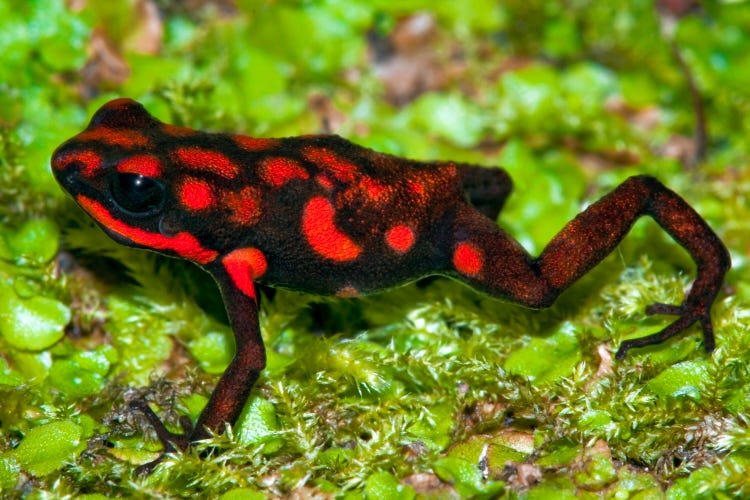News of the week
Saving amphibians in Colombia and the rest of the world. Reinforcing the Migratory Bird Act.
Conservation efforts for amphibians
ProAves reserve struggles to protect frogs
In 2008, ProAves, an international conservation organization, purchased and established the Ranita Dorado ProAves Reserve, a 284-acre wildlife sanctuary on the western slopes of the Colombian Andes that ranges in elevation from 5,000 to 6,200 feet above sea level.
ProAves chose this parcel of land because of its biodiversity. The mountainsides are home to 291 species of birds, a half-dozen of which are endemic to Colombia. It was also the first preserve in the world that was intended as a haven for native amphibians.
Back when the ProAves folks acquired and dedicated the reserve, there had already been significant environmental degradation to the land. In the intervening years, the organization has had much success in regenerating the native landscape, enough to serve as habitat for mammals, birds, and amphibians native to the area.
Rainforest destruction still occurs around the preserve, which is of concern to the survival of the species within the reserve’s boundaries. Of particular concern are the Tolimense poison frog (Andinobates tolimensis) and the dotted poison frog (Andinobates dorisswansonae). Both species are Colombian endemics and considered Vulnerable by the International Union for the Conservation of Nature (IUCN).
Saving amphibians worldwide
Going back ten years or longer, folks noted that amphibians worldwide were in crisis due to the spread of the chytrid fungus (Batrachochytrium dendrobatidis), known as Bd for short. Bd is a skin infection for amphibians that can lead to disruptions of the organisms’ electrolytes. Death is caused by the creature’s inability to maintain homeostasis, such things as water balance and blood sugar levels. By 2009 over 120 species of amphibians had not been recorded and were believed to have gone extinct due to Bd.
Amphibian decline was first noted in the 1950s. By 1989, the situation had become so dire that the IUCN Species Survival Commission (SSC) established the Declining Amphibian Populations Task Force (DAPTF) to investigate the causes and cures of the problem. The IUCN conducted a global amphibian assessment in 2004. Today, 41 percent of amphibians are listed as Threatened on the IUCN’s Red List of Threatened Species,
Needless to say, climate change poses its own risk to amphibians. Research focused on the Pacific Northwest found that climate change may make this region too hot and too dry for the frogs and salamanders that live there.
With their reliance on clean water and intact habitats, amphibians are indicator species. You might think of this as the frogs and salamanders serving as canaries in the coal mine of the planet. And maybe instead of thinking tough luck for the little creatures, we might consider that they are giving us a warning. If we don’t start paying attention to their situation, we may be following them on the Threatened or Endangered lists.
Indeed, declines in amphibian populations have been linked to human health. In Central America, the steep declines in amphibian populations caused by Bd have been linked to an increase in cases of malaria. In 1980, there were fewer than 1,000 cases of malaria in Costa Rica and Panama. After Bd began decimating amphibians, malaria cases began to rise, up to around 7,000 cases in Costa Rica in the mid-1990s and 5,000 in Panama in the mid-2000s. (ProAves)
More protections proposed for migratory birds
Considered a backbone of modern conservation, the Migratory Bird Treaty Act of 1918 protects birds that migrate between the U.S. and Canada. Since 1936, when Mexico joined as a partner in the treaty, birds flying across our southern border were protected as well. Japan and Russia became signed on to the treaty in the 1970s.
Migration can increase risks to birds. Most birds migrate in flocks, which makes them easy targets for hunters. Migrating birds can also have a difficult time seeing obstacles that humans have created, such as power lines and communication towers. The law has been interpreted to require shielding or to make it easier for the birds to see obstacles when we build such structures.
The treaty has has had support from both Democratic and GOP administrations. The Trump administration, however, tried to weaken the law, maintaining that the treaty only protected birds from being deliberately killed by humans. Industry would be off the hook to protect birds from oil pits, power lines, and other hazards.
Though the actions of the Trump administration were rolled back in the courts, lawmakers and others have come to believe that it is time to strengthen protections for birds.
As I said above, the law has been interpreted to require industry to make towers and buildings safe for bird migration; that is how the Trump administration had the legal leeway to exempt construction activities from the law. Prompted by these actions of the previous administration, the office of Representative Alan Lowenthal, a Democrat from California, announced on July 29th that he and Pennsylvania Republican Brian Fitzpatrick were introducing the Migratory Bird Protection Act that would amend the wording of the treaty to incorporate the longstanding interpretation of the law into the law itself. Commenting on the bill, Congressman Fitzpatrick said:
We must take the necessary steps to protect and conserve migratory bird populations. We must ensure that longstanding protections for birds are fully maintained while providing greater regulatory certainty. I am proud to join Rep. Lowenthal in introducing the bipartisan Migratory Bird Protection Act, which takes important steps to protect millions of migratory birds.
For more news on the environment follow me on Twitter @EcoScripsit





